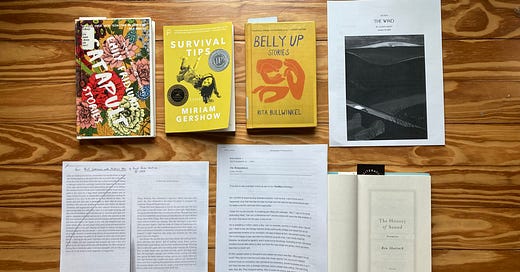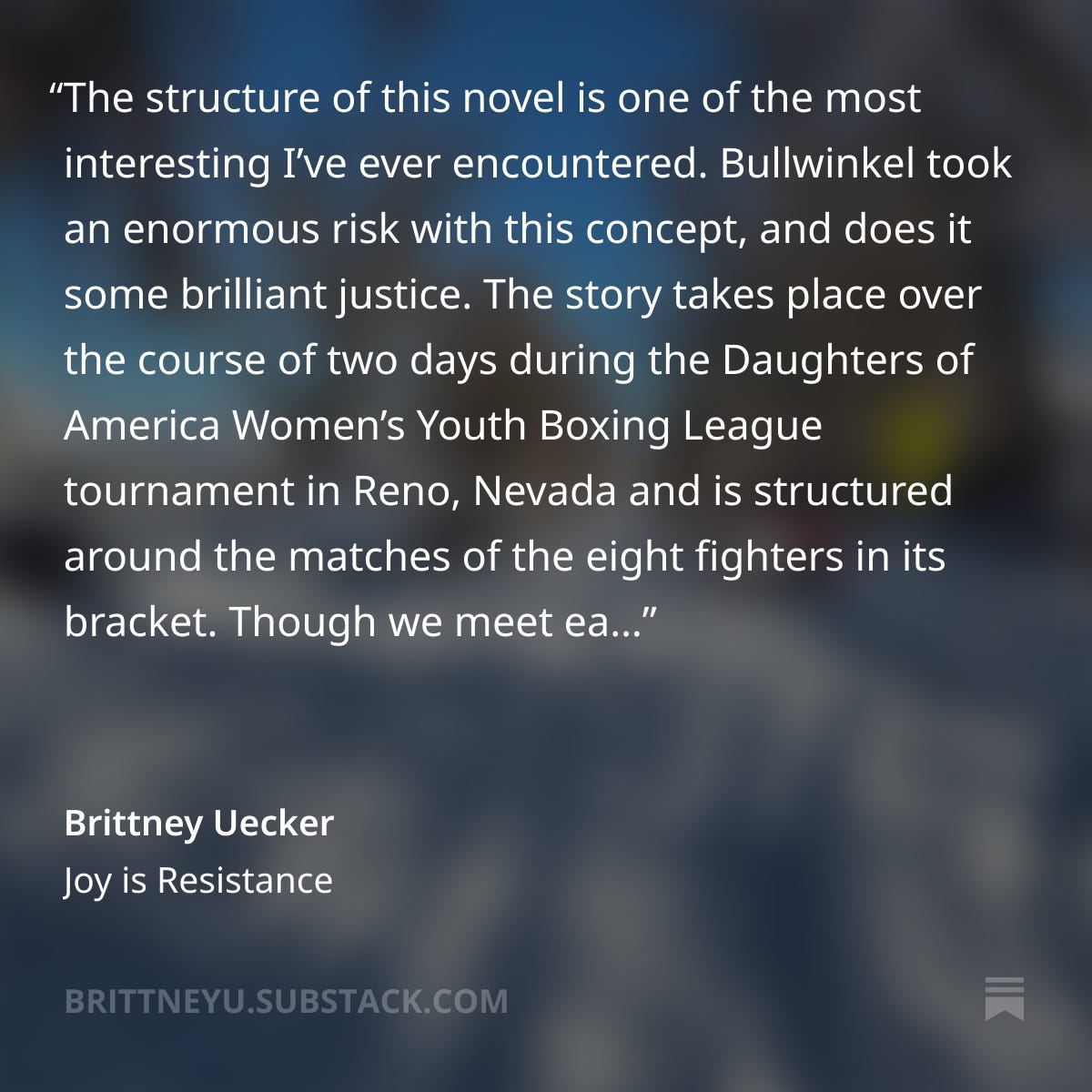2025 week 4 — reading, teaching, writing
Emily Fridlund, Miriam Gershow, Rita Bullwinkel, Lauren Groff, David Foster Wallace, Aimee Bender, Ben Shattuck + some more "show your work" novel drafting...
Thinking and looking back, as we close in on the end of January, this just might be the most I’ve ever read in a month. In part that feels like classic “new year/new start” ambition and drive. It also feels like… double-downing on art is one of the best ways I know how to combat everything feeling so frustrating and maddening. I’ve been writing a good amount, trying to get back to drawing more, reading a ton, buying books and records, promoting and recommending short stories and novels as much and as best I can.
was kind enough to feature me today in his “Friday Five” interview series. I talk some about being an editor and how I got into it and what I love about editing lit journals. I also talk a little about this very reading log, and touch on the above idea — “Most days, I read a short story first thing in the morning, with my coffee. I think it all ‘helps me as a writer and editor’ but even more than that, it feels like it helps me as a human.”I finished John Darnielle’s Wolf in White Van last weekend. I didn’t love it, but I liked it quite a bit. It felt like in a similar vein, to a degree, as Kevin Wilson’s Now Is Not the Time to Panic, one of my fave reads of a couple years ago. Also reminded me some of Tomorrow and Tomorrow and Tomorrow. I’d def recommend it. A fun, easy, fast ~200 page read that I really enjoyed spending time with.
the stories I read this week:
Sat. 1/25: “Lock Jaw” by Emily Fridlund
This happens with at least a story every week where, by the time I write up this log, I don’t remember anything at all about the story. It makes me think I should take some more notes or at least update the draft of this post once or twice throughout the week, closer to my reading of said story. That said, it’s kinda interesting to think about which stories “stick” and which don’t.
*
Sun. 1/26: “Survival Tips: Toddler Birthday Party” & “Big Home” by Miriam Gershow
“Survival Tips” is a shortie, and I loved it, so rolled right into “Big Home,” and it’s probably my fave story yet in Gershow’s collection, SURVIVAL TIPS. I sometimes feel like “this could be a novel!” to be a tiny bit of a disservice to short stories themselves as art form… tho I would gladly read a whole novel about Hogan! Such an interesting character, and a great set-up, where he is working at a Telephone Relay Service call center, transcribing and reciting one side or the other of phone conversations for callers with hearing disabilities. So many interesting questions and narrative possibilities in this role of medium.
*
Mon. 1/27: “Harp” by Rita Bullwinkel
wrote in her last update about Bullwinkel’s novel, Headshot, in a way that made it sound really interesting, and made me curious, so I got it from the library. I’m ~50 pages in and already totally in love with it, can’t shut up about it or stop recommending it, and have already heard from three different people who have also picked it up from said incessant recommending. I bet I’ll finish it this weekend and so will probably write a bit more about it, as a whole, next week.I also grabbed from the library Bullwinkel’s collection, Belly Up. “Harp” is the first story, and it’s great. I’m excited to read more!
*
Tues. 1/28: “The Wind” by Lauren Groff
I read Groff’s “Between the Shadows and the Soul” last month and wrote a little about it in my very first post here on this reading log, and
commented that he’d read it too, and also noted “The Wind” as giving him some “Flannery vibes.” I’d so enjoyed “Between the Shadows and the Soul” that it made me want to read more, and I was super curious about those Flannery vibes! So I printed it out… and finally got to it this week.It’s great. Wow. Expertly packs an incredible amount of emotion, and also, on a craft-level, just does a couple of really interesting moves with POV. Definitely feels like a story I’ll revisit. Maybe sooner than later? Think I might teach it later this semester.
*
Wed. 1/29: “Forever Overhead” by David Foster Wallace & “The Remember” by Aimee Bender
I don’t typically count my class reading as my “daily story,” but I wanted to revisit these one more time before class and that took priority over reading a story for fun, so I’m counting ‘em. Both are great. I’d never taught them together before and I thought it went really well. Lots of discussion about pacing and “story time,” and also how you can take a relatively simple “conceit” (13 year old at pool on birthday climbs diving board; woman’s boyfriend literally devolves (ape… sea turtle… salamander…)) and build it out and really make it specific and uniquely your own.
I teach “Forever Overhead” every semester I get to teach fiction, and often many of the students in class really dislike it, and I love those class discussions interrogating why, and also pushing us toward what we can learn from the story, whether we loved or hated it or somewhere in between.
*
Thur. 1/30: “August in the Forest” by Ben Shattuck
Another marvel, a gem, etc. etc. I’m running short on ways to enthuse about and recommend this book. Hyperbolic to say it’s up there among the best collections I’ve ever read? I’m still only halfway through it and my buddy Russ just last night told me he’s excited how many great stories I still have to get to. I feel like they could be duds and the book would still be an all-timer. I’m not sure what I’m gonna do with myself if they’re all this good. If there’s still a new fave to come.
*
Fri. 1/24: N/A
I read a little of Rita Bullwinkel’s Headshot, and then did some house chores, and then went to the coffeeshop to write…
Here’s something I wrote/revised this week:
Saw lay on his couch, staring up at the ceiling. Unable to fall asleep, unable to slow his brain on its hamster wheel.
He’d run himself exhausted, he’d gone through the motions of as many of the yoga poses as he could remember, he’d tried to meditate his way to some kind of serenity or inner peace. Nothing worked.
“Fine,” aloud, to himself. He jolted up, sprung himself up from the couch. Time to change tactics.
In the back of his closet were boxes and boxes of his life. His memories. Memory boxes. Sawyer went and got them, carried them out to his living room. Going through them was what he did when he didn’t know what else to do. Going through them was one of the ways he punished himself.
Photo albums and yearbooks, birthday and Valentine’s Day cards from exes. Concert tickets, high school graduation pamphlet. An old black plastic film canister of pennies flattened with images of science museums and roadside attractions, another with three quarters given to him by his grandfather — one each from his own year of birth, his son’s, and his grandson’s, Sawyer himself.
I met with my writer group buddies last night. They’d read the first five short chapters I have so far for this new project and were really encouraging and full of praise and excited for it. Which is kinda all I want from sharing something in progress, much less this early in progress. Let’s meet so I have a deadline to finish some pages to send you; and even if a lot of this changes, let me know if there’s something here that’s working, if I should keep at it, or if something here feels too much like it isn’t working. Give me enough encouragement to feel inspired to keep pushing. Which is exactly what happened. A great hang last last night, and then two or three hours of inspired writing at the coffeeshop this morning and afternoon.
I started with some old notes I had for a next chapter. It was basically all backstory. Rereading over them this morning, I got excited about story beats and ideas that I’d forgotten, but also I felt pretty “meh” about typing them up and turning them into a chapter. It all felt too inert, too reliant on the past without really progressing the story forward. It felt like a waste of a chapter and not worth typing up or working on… but, at the same time, it introduced some ideas into the novel that I felt like were interesting and I wanted to keep playing with.
And then I remembered what I had basically spent the week teaching in my “Art of the Essay” class. Their first major essay is a New York Times “Modern Love” essay, so we’ve spent the last week reading and discussing examples, all toward the end goal of writing one ourselves. And one thing I’ve been highlighting is how often (nearly always? maybe literally always?) there’s a “central/primary scene,” a concrete, specific moment in time that acts as entrypoint into or instigating factor for thinking about the essay’s larger ideas and emotional weight.
And so: these memory boxes.
It isn’t the most active chapter, but there’s something happening in the present. And the remembering no longer happens out of nowhere, but is provoked by physical action. And, as follow-up/in response to an exhausting run, which is a fun building on a previous chapter. And then, too, the chapter will end with this active remembering via looking through these photo albums pushing Saw into his next action, as response.
And that’s novel writing. Get some words down, make a little forward progress, answer one question or problem at a time… and then just keep doing that over and over and over and over and over and over…
*
Thanks!
—Aaron







I read The Wind last year—amazing
Headshot is going to win all the awards.
Really enjoying this melange of reading, writing, reflection, etc. The day before yesterday I read a page from a travelogue, the writer is taking a bus to village and talking to the driver, and the driver told the writer a story that summoned an abandoned short story I'd conceived after a night in a strange hotel outside of a Germany five years ago. What kind of witchery is that? I have to believe it doesn't happen without the kind of constant surfacing of story that you're engaged in right now.